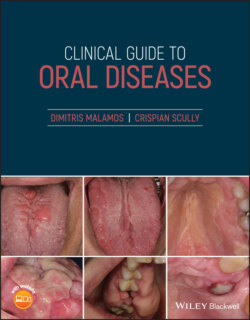Читать книгу Clinical Guide to Oral Diseases - Crispian Scully - Страница 44
Case 3.8
ОглавлениеFigure 3.8
CO: A 70‐year‐old man presents with an extensive brown lesion covering most of his lower lip.
HPC: The lesion had existed for almost one year and started as a small pigmented plaque which had gradually increased in size, and finally covered the whole of his lower lip over the last three months (Figure 3.8).
PMH: His medical history revealed a prostate cancer, removed with radical prostatectomy eight years ago, and a mild heart attack treated with coronary artery bypass, antiplatelets, cholesterol agents, and angiotensin converting enzyme (ACE) inhibitor tablets. He was a chronic smoker (>40 cigarettes/day) as well as a drinker (up to 5 glasses of wine/meal) and he used to go for fishing before his heart attack three years ago. His family history was negative.
OE: The examination revealed a large superficial lesion of a very dark brown discoloration, covering all the length of his lower lip vermillion border and submerging into his adjacent chin with bulbous brighter leaf‐like lesions. This lesion showed a small ulcer of 0.8 cm in maximum diameter centrally and three (small) satellite pigmented lesions at the inner labial mucosa, both being associated with two submental and one left submandibular palpable. lymph nodes. No other pigmented lesions were found on his skin or oral and other mucosae.
Q1 What is the possible diagnosis?
1 Solar lentigo
2 Actinic prurigo
3 Lip cyanosis
4 Smoking melanosis
5 Lentigo maligna melanoma
Answers:
1 No
2 No
3 No
4 No
5 Lentigo maligna melanoma is the cause. Lentigo maligna melanoma affects old patients especially at the peak of their 7th or 8th decade of life, who have had chronic exposure to ultraviolet radiation. It appears as a very extensive pigmented lesion on the sun‐exposed skin of face or lips with irregular borders, large diameter (>4 mm), heterogeneous coloration and follows a pigmented lesion (lentigo maligna). The present patient was 70 years old, a heavy smoker and drinker, and had spent most of his time fishing; so he was totally exposed to sun radiation. He had a lip discoloration ranging from dark to light brown color and a former pigmented lesion from which the present lesion originates.
Comments: Chronic exposure to sun is responsible, apart from lentigo maligna melanoma, for other lesions like solar lentigo and actinic prurigo. Solar lentigo is a small (<1 cm) innocent pigmented lesion while solar prurigo affects certain groups of patients from North America and Asia, and is presented as numerous lip and skin lesions with a small risk of malignant transformation. Cyanosis and smoking melanosis are easily excluded from the diagnosis as the first one affects the vermillion border of both lips and its color is dark blue, which is closely related to the level of deoxyhemoglobin in the blood, while smoking melanosis is mostly observed in the anterior gingivae and inner surface of the lower lip.
Q2 Which of the tools below is/are not that useful for clinicians' diagnosis of solar lentigo melanoma?
1 Biopsy
2 Dermoscopy
3 Photography
4 PET scan
5 CT/MRI
Answers:
1 No
2 No
3 Photography is useful for the mapping of moles, rather than pigmented lesions with supraclavicular lymph node metastases (SLM) diagnosis. By comparing a series of photos taken at different intervening periods, clinicians try to recognize any changes in morphology, structure, and color of suspicious moles, as well as to detect any early melanoma.
4 No
5 No
Comments: Dermoscopy is a useful tool for distinguishing suspicious melanoma lesions from inflammatory dermatoses by using a high quality magnified lens and a strong lighting system. Biopsy is mandatory to confirm the clinical diagnosis of melanoma, while CT or MRI detect possible metastases (local/systemic). PET scan shows the presence of active disease in the whole body.
Q3 Which is the best treatment for lentigo maligna melanoma?
1 Cryotherapy
2 Radiotherapy
3 Laser CO2 therapy
4 Imiquimod cream application
5 Surgery
Answers:
1 No
2 No
3 No
4 No
5 Surgery is the best treatment possible, as the wide removal of tumor with clear margins of 9 mm has the smallest recurrence rate (<10%).
Comments: All the other techniques are less invasive, but show a high rate of recurrence. This could be attributed either to failure of laser CO2 to reach the whole lesion (in depth or size) or to treatment delay of secondary misdiagnosed depigmented lesions after imiquimod application.
